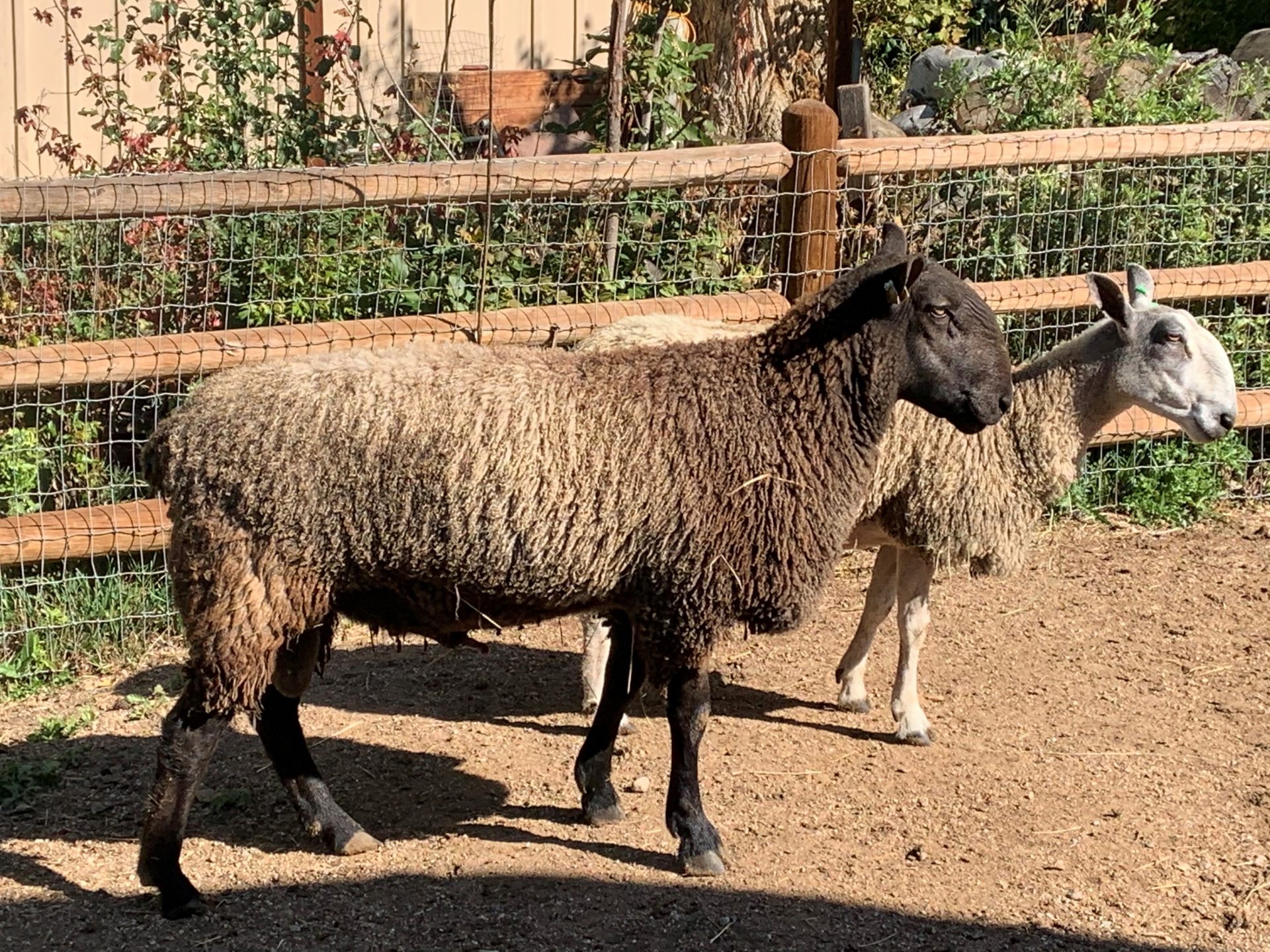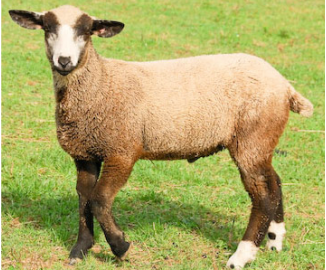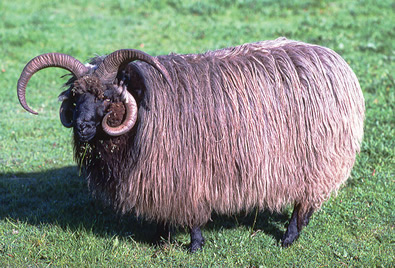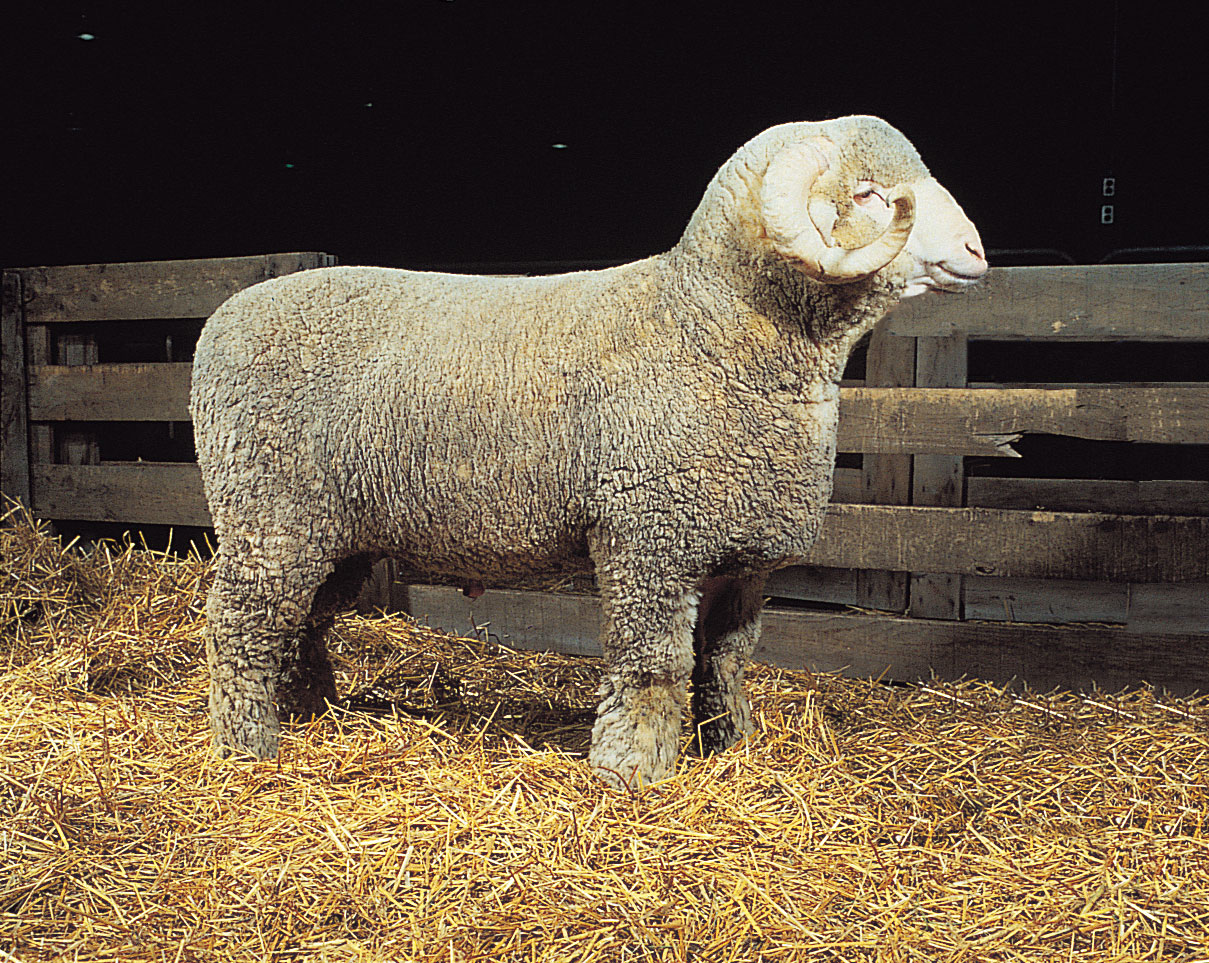
BLUEFACED LEICESTER
The Bluefaced Leicester is very distinct with its Roman nose, long, upright earset, and deep blue skin contrasted with soft, white, demi-lustre wool. The BFL also has recessive color genetics, and “Natural Colored” lambs can be produced. Both rams and ewes are polled. They have a clean head/face, legs, and belly (free of wool). The BFL is classified as a Longwool breed.
The Bluefaced Leicester Union of North America

Photo credited to http://www.sheep101.info/breedsB.html
CALIFORNIA VARIEGATED MUTANT
The California Variegated Mutant (CVM) breed was developed by Glen Eidman in the early 1960s. Mr. Eidman developed CVMs from a Romeldale flock (Romney and Rambouillet cross) specifically with handspinners in mind. Many CVMs have a badger face with color patterns in the wool varying widely, including gray/black, solid black, brown, silver and spotted. Wool type is medium-fine with a staple length of 3 to 5 inches and a spinning count of 58 to 64.
American Romeldale/ CVM Assocation, Inc.
Photo credited to https://www.britannica.com/animal/Corriedale
CORRIEDALE
The Corriedale originated in New Zealand and Australia and was developed from Merino and Lincoln crosses. Corriedales were imported into the United States in 1914. Wool type is medium to medium-fine with a staple length of 3-1/2 to 6 inches and a spinning count of 50s-60s.
American Corriedale Association, Inc.
Photo credited to http://luxurycotswoldproperties.co.uk/top-10-important-facts-cotswolds/
COTSWOLD
The Cotswold is one of the oldest breeds of sheep, serving as the cornerstone of England’s wool economy throughout the Middle Ages. Cotswolds were developed from Border Leicester, Hampshire, and German Whitehead crosses and were imported into the United States in 1832. Wool type is coarse to very coarse with a staple length of 8 to 14 inches and a spinning count of 40 and below. The wool is noted for its natural wavy curls. A notable characteristic of this breed is the long wool hanging over the face.
Cotswold Breeder's Association
Photo credited to http://www.icelandicsheep.com/
ICELANDIC
The Icelandic sheep are of medium size, fine boned with open face and legs and udders. The breed has both polled and horned individual of both sexes but it is primarily horned. Icelandic sheep are not particularly tall but broad and have an excellent conformation as a meat breed. The fleece has an inner and outer coat typical of the more primitive breeds with the fine undercoat being called Thel and the long, coarser outer coat called Tog. The fleeces are open and not very greasy. The average fleece weighs 4-5 lbs. The Thel is down like, springy, lustrous and soft. The longer tog coat is similar to mohair, wavy or corkscrewed rather than crimped.
Icelandic Sheep Breeders of North America
Photo credited to http://www.sweetgrass-jacobs.com/
JACOB
The Jacob is an English long wool breed with distinctive large spots and a set of four horns. The Jacob fleece is properly described as white with black spots. The white and the black wool, which may fade at the tips to dark brown, may blend to various shades of grey. The wool is of medium grade. Ideally, the animal should be 40% black and 60% white, with certain characteristic patterns. The legs should be predominantly white, with black hooves and black knees and hocks. The desired Jacob face is frequently referred to as “badger faced’, with black cheeks and muzzle, but a white blaze down the front of the face.
Jacob Sheep Breeders Association
Photo credited to https://www.slowfoodusa.org
NAVAJO-CHURRO
The Navajo-Churro was developed from Spanish Churros and was the first breed of domesticated sheep in the United States. Native Americans have historically used the wool to make blankets and rugs. The fleece contains three distinctive fibers: (1) an outer coat up to 10 inches long with a spinning count in the 30s, (2) a shorter inner coat which may spin as fine as 64, and (3) kemp, which must not be more than 2 percent of the entire fleece.
Navajo Churro Sheep Association
Photo credited to http://www.wool.ca
RAMBOUILLET
The Rambouillet was King Louis XVI’s answer to the Spanish Merino. In 1786, the King of Spain sent 359 Merinos to France to help improve native French sheep stock. French records indicate the resulting sheep have been pure bred at the Rambouillet Estate since 1801. The Rambouillet was imported into the United States in the mid-1800’s. Wool type is fine to very fine with a staple length of 2 to 4 inches and a spinning count of 60s-80s.
American Rambouillet Sheep Breeders Association
Photo credited to http://everranch.com/
SHETLAND
The Shetland is an ancient sheep originating from the British Isles and imported into Canada and the United States in the 1980s. Shetland wool comes in a great range of natural colors which adds to its value, especially for hand spinners. Traditionally, Shetland wool is used for wedding shawls which can be pulled through a bride’s ring. Shetland wool is the finest of the British Isles breeds with a staple length of 4 to 5 inches.
North American Shetland Sheep Breeders Association
Photo credited to http://wensleydale-sheep.com/
WENSLEYDALE
The modern Wensleydale is a very large long wooled sheep, with long-stapled (up to 12″), lustrous wool that falls in long curly ringlets almost to ground level in unshorn sheep. Described by the British Meat and Livestock Commission as “probably the heaviest of all our indigenous breeds.” It is a visually striking sheep with considerable presence. It has a bold and alert carriage which is accentuated by its broad, level back and heavy muscling in the hindquarters. It has a distinctive deep blue head and ears, which should be clean except for a well developed forelock of wool. Both sexes are polled.
North American Wensleydale Sheep Association